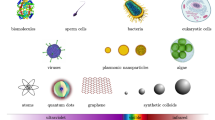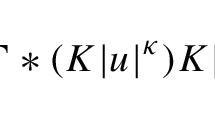Abstract
The classical wave-particle problem is resolved in accord with Newton's concept of the particle nature of light by associating particle density and flux with the classical wave energy density and flux. Point particles flowing along discrete trajectories yield interference and diffraction patterns, as illustrated by Young's double pinhole interference. Bound particle motion is prescribed by standing waves. Particle motion as a function of time is presented for the case of a “particle in a box.” Initial conditions uniquely determine the subsequent motion. Some discussion regarding quantum theory is preseted.
Similar content being viewed by others
References
I. Newton,Opticks, or Treatise of Reflections, Refractions, Inflections and Colours of Light, 4th edn. London, 1730 (Dover, New York, 1952; a reprint of the 1931 edition of G. Bell and Sons).
Th. Young,Philos. Trans. R. Soc. London, pp. 12, 387 (1802); p. 1 (1804).
A. Fresnel,Mem. Acad. Sci. 5, 339 (1826).
W. R. Hamilton,Philos. Trans. R. Soc. London, p. 307 (1834).
Maupertuis,Mem. Acad. Paris, p. 417 (1744).
M. Planck,Verh. Dtsch. Phys. Ges. 2, 202, 237 (1900).
A. Einstein,Ann. Phys. (Leipzig) 17, 132 (1905).
L. de Broglie,Compt. Rend. 177, 507 548 (1923);179, 39, 676 (1924);Philos. Mag. 47, 446 (1924);Ann. Phys. (Paris) 3, 22 (1924).
E. Schrödinger,Ann. Phys. (Leipzig) 79, 361, 489 (1926);80, 437 (1926);81, 109 (1926).
E. Madelung,Z. Phys. 40, 322 (1926).
L. de Broglie,Compt. Rend. 183, 447 (1926);184, 273 (1927);185, 380 (1927);J. Phys. (Paris) 8, 225 (1927);Nonlinear Wave Mechanics (Elsevier, Amsterdam, 1960).
D. Bohm,Phys. Rev. 85, 166, 180 (1952);Prog. Theor. Phys. 9, 273 (1953);Causality and Chance in Modern Physics (Princeton University Press, Princeton, New Jersey, 1957).
J. P. Wesley,Phys. Rev. 122, 1932 (1961).
J. P. Wesley,Nuovo Cimento 37, 989 (1965).
R. D. Prosser,Int. J. Theor. Phys. 15, 169 (1976).
R. D. Prosser,Int. J. Theor. Phys. 15, 181 (1976).
C. Philippidis, C. Dewdney, and B. J. Hiley,Nuovo Cimento B 52, 15 (1979).
J. O. Hirschfelder and A. C. Christoph,J. Chem. Phys. 61, 5435 (1974).
C. Dewdney and B. J. Hiley,Found. Phys. 12, 27 (1982).
J. P. Wesley,Causal Quantum Theory (Benjamin Wesley, 7712 Blumberg, West Germany, 1983).
Author information
Authors and Affiliations
Rights and permissions
About this article
Cite this article
Wesley, J.P. A resolution of the classical wave-particle problem. Found Phys 14, 155–170 (1984). https://doi.org/10.1007/BF00729972
Received:
Issue Date:
DOI: https://doi.org/10.1007/BF00729972




